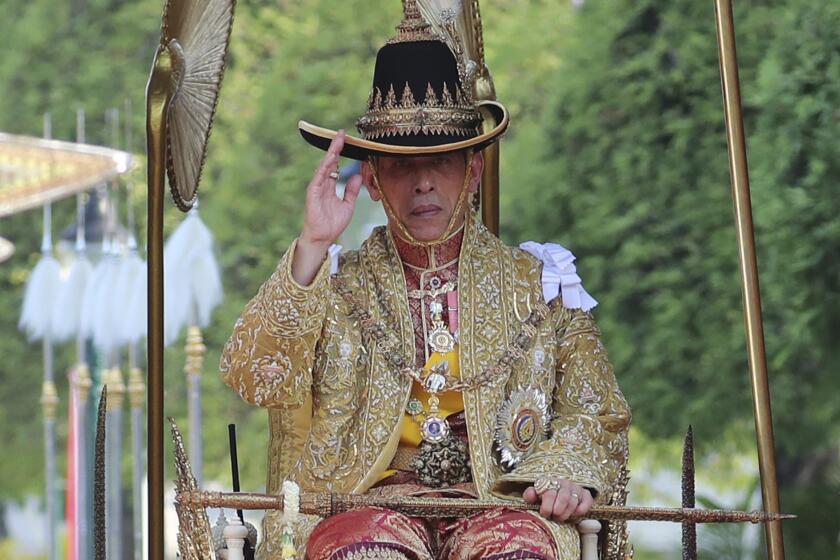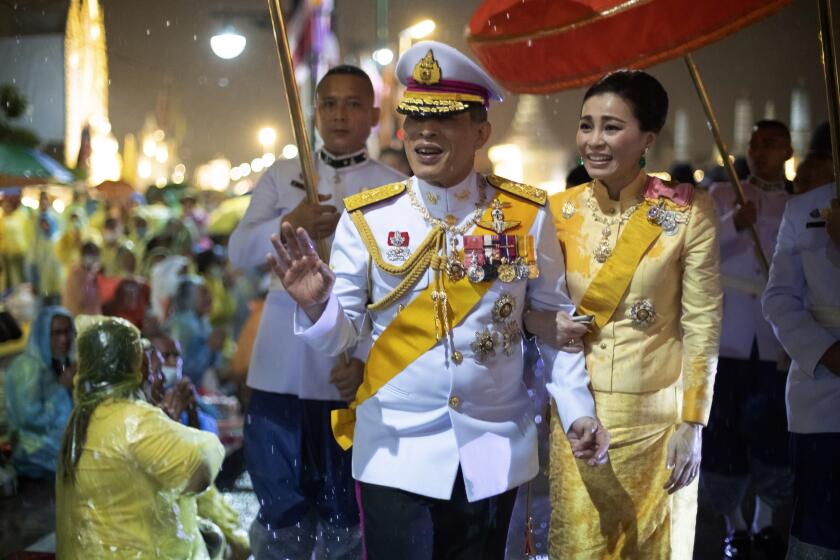The Thai king’s companion vanished after upsetting the queen. Now she’s back in the spotlight
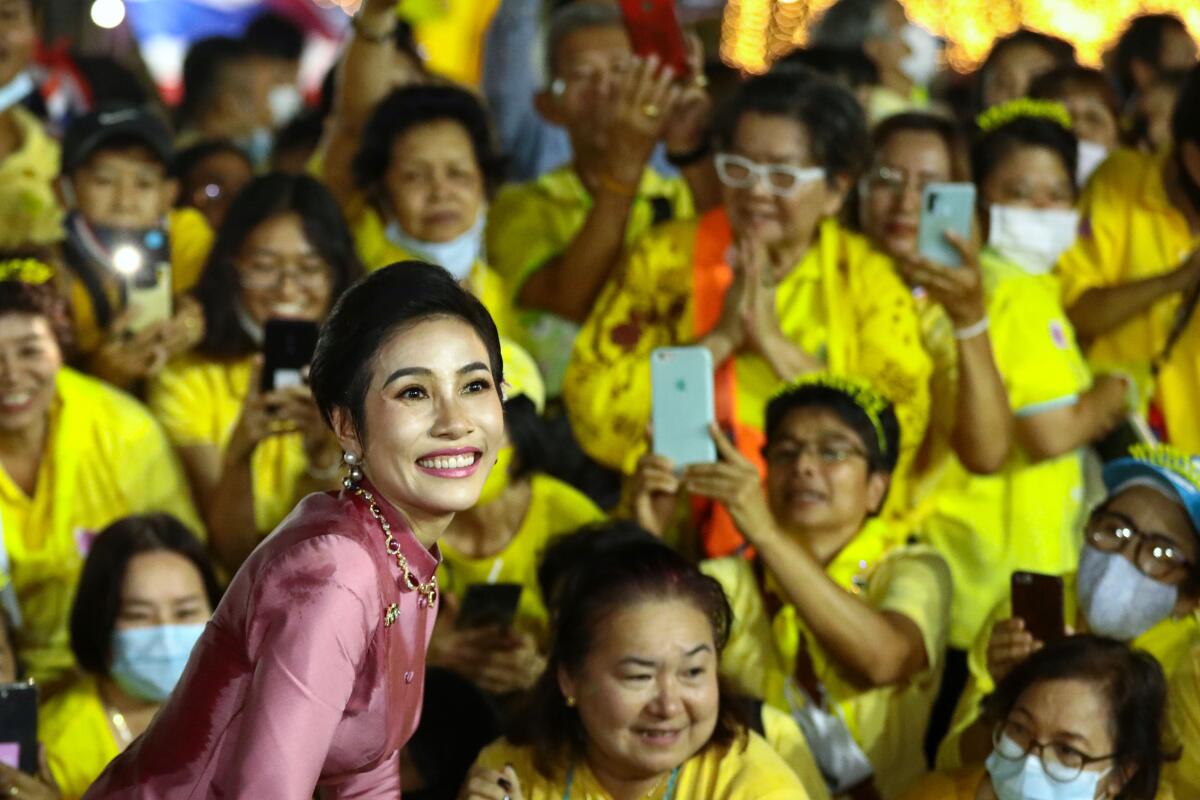
One day she’s meeting flood victims, cheerily handing out relief supplies in a baseball cap and camouflage trousers. The next she’s sitting among worshipers at a Buddhist temple, legs folded under her elegant silk tube skirt, a smile stretched across her face.
And sometimes — only sometimes — Sineenat Bilaskalayani is seen in the same frame as the king and queen of Thailand. On these occasions she is relegated to the background, just another bejeweled member of the royal entourage. The queen does not appear to make eye contact.
Sineenat is Thailand’s royal noble consort, a title given to a companion of the king who is not his wife. She is the first person named to that position in nearly a century. At a time of unprecedented ferment against Thailand’s monarchy, she and her unusual role have been thrust into the spotlight.
In choreographed public appearances, the 35-year-old Sineenat, a former army nurse raised in the northern countryside, has been the beaming, youthful picture of accessibility, posing for selfies and crouching to clasp the hands of genuflecting fans. For a palace that has cultivated an aura of near-godliness despite Thailand’s pretenses to constitutional rule, the images suggest a concerted effort to win admirers with her common touch.
“It’s strategic,” said Pavin Chachavalpongpun, a Thai academic. “It’s a way of narrowing the gap between the monarchy and the people.”
But to the monarchy’s critics — including thousands who have risked arrest and braved police water cannons and tear gas to join Thailand’s greatest pro-democracy protests in years — Sineenat represents something more troubling: the return of polygyny to a royal court they view as regressive and feudal, and a reminder of the unpredictable behavior of the 68-year-old, thrice-divorced King Maha Vajiralongkorn.

It was just last year, after all, that Sineenat disappeared — reproached for “misbehavior and disloyalty” in an extraordinary, two-page statement in the royal gazette that accused her of trying to outshine the queen and causing discord in the palace.
Sineenat was stripped of her military rank and the titles the king had piled upon her. For nearly a year there was no news of her whereabouts. Whispered comparisons alluded to other spurned lovers of the king who had basically vanished — like his second wife, who has lived in anonymity overseas after he divorced her and disowned four of their children, or his third, who has not been seen publicly since their split in 2014.
Then, just as suddenly, Sineenat was back in the royal glare. In August, a six-line command from the king restored her titles without explanation and declared that her record was unblemished.
This fall, with Vajiralongkorn making a rare extended visit to Thailand from his usual residence in Germany, Sineenat has played a key role in the palace’s PR blitz, popping up across the country, usually solo, though hardly ever near the king.
“It seems that the king thinks of her like his own private Barbie doll,” said Tamara Loos, a history professor at Cornell University who studies the Thai monarchy. “He puts her away and takes her out at will.”
::
For all its reputation as an open-minded, tourist-friendly “Land of Smiles,” Thailand remains a deeply traditional society governed by stultifying hierarchies of sex, age and class. The monarchy sits at the apex; the military, which has led the government since a 2014 coup, right below.
The loosely organized protest movement that emerged this summer has not only demanded a new government and constitutional changes but also directly challenged the ultraconservative gender roles upheld by the king during his lately troubled four-year reign.
Tattep Ruangprapaikitseree and other young activists want to rein in the monarchy and its military allies who have ruled Thailand since a 2014 coup.
The protest leaders are younger, with more women and LGBTQ people among their ranks than in almost any other recent grassroots political movement in Asia. High schoolers have risen up against rules governing how they dress and style their hair. Demonstrators have flown rainbow flags. Drag queens — including some impersonating Sineenat — have strutted across protest stages.
A 21-year-old college student, Panusaya Sithijirawattanakul, produced a defining moment in August when she read out a 10-point manifesto for limiting the monarchy’s powers. The electrifying appearance broke a long-standing taboo against publicly criticizing the king, a criminal offense punishable by up to 15 years in prison. She was detained for weeks on charges of unlawful assembly before being released on bail, and rejoined the protests this week.
“The monarchy is a very conservative institution, and its gender roles are so, so conservative, while we treat everyone as equals,” said 23-year-old protest leader Tattep Ruangprapaikitseree, who is gay.
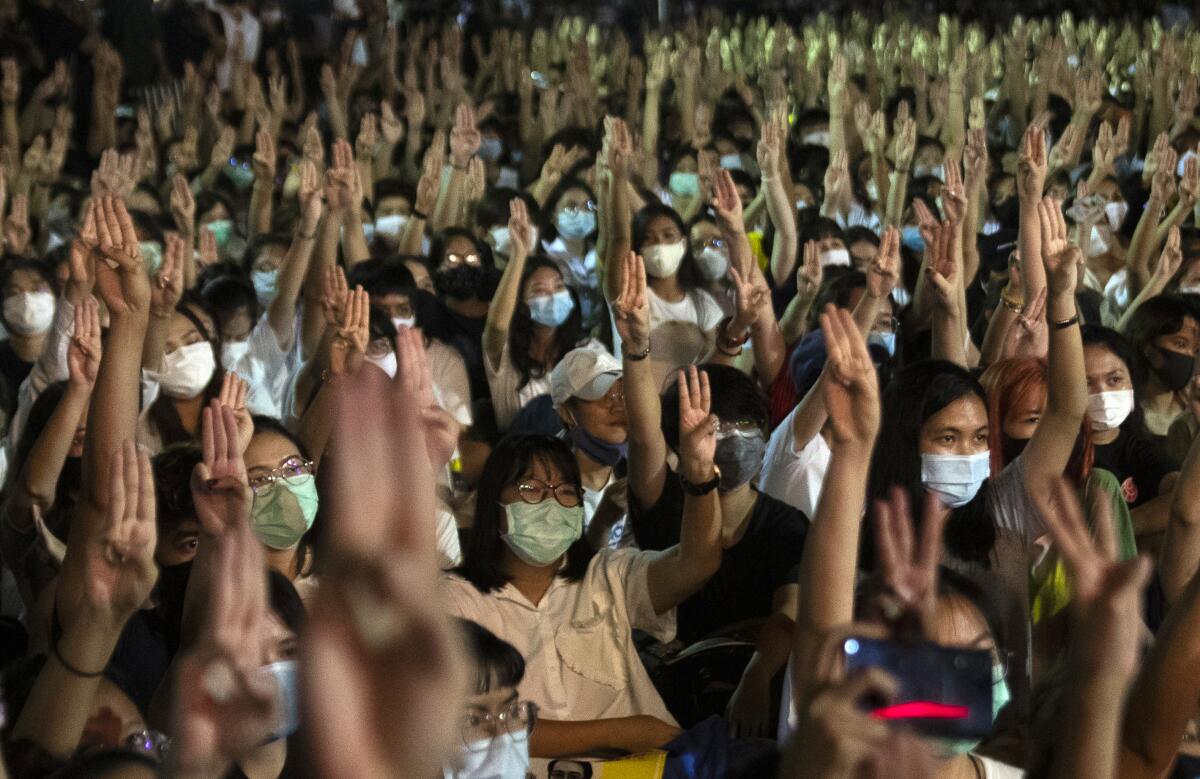
Tattep and other protest organizers have generally avoided discussing the private affairs of a king who still enjoys support among older and middle-class Thais, not to mention the powerful military. Once, when an onstage protest leader referred to Sineenat — making a crude joke about her nickname, Goy, which also means a cheap, spicy dish of raw beef — a female colleague took the microphone to reprimand him.
Instead, the movement has focused on the costs required to maintain Vajiralongkorn’s large retinue in Europe, including a hotel in the Bavarian Alps where he is reported to live with Sineenat and other female courtiers, and a separate residence in Switzerland used by the queen.
Thailand’s King Vajiralongkorn is facing demands for limits on his powers and public oversight of an estimated $70 billion in crown wealth.
Although the king controls a royal fortune estimated at $70 billion, the government this year budgeted $1 billion in taxpayer funds for the monarchy, despite an economic slowdown that has worsened since the COVID-19 pandemic.
“The people have always known about the king’s private life,” Tattep said. “But to have that lavish private life, it must use a lot of money. That is what we are questioning.”
::
As much as Vajiralongkorn has sought to evade scrutiny, his relationships with women have turned the royal family — regarded as a model of monogamy and moral authority during his father’s seven decades on the throne — into fodder for gossip.
His first wife, a cousin, bore the first of his seven children, Princess Bajrakitiyabha. Of the five children he had with his second wife, an actress, only one remains part of the royal family: Princess Sirivannavari, a fashion designer and social media star.
His third wife bore a son, Prince Dipangkorn Rasmijoti, who is believed to live near the king in Germany and is the presumptive heir to the throne.
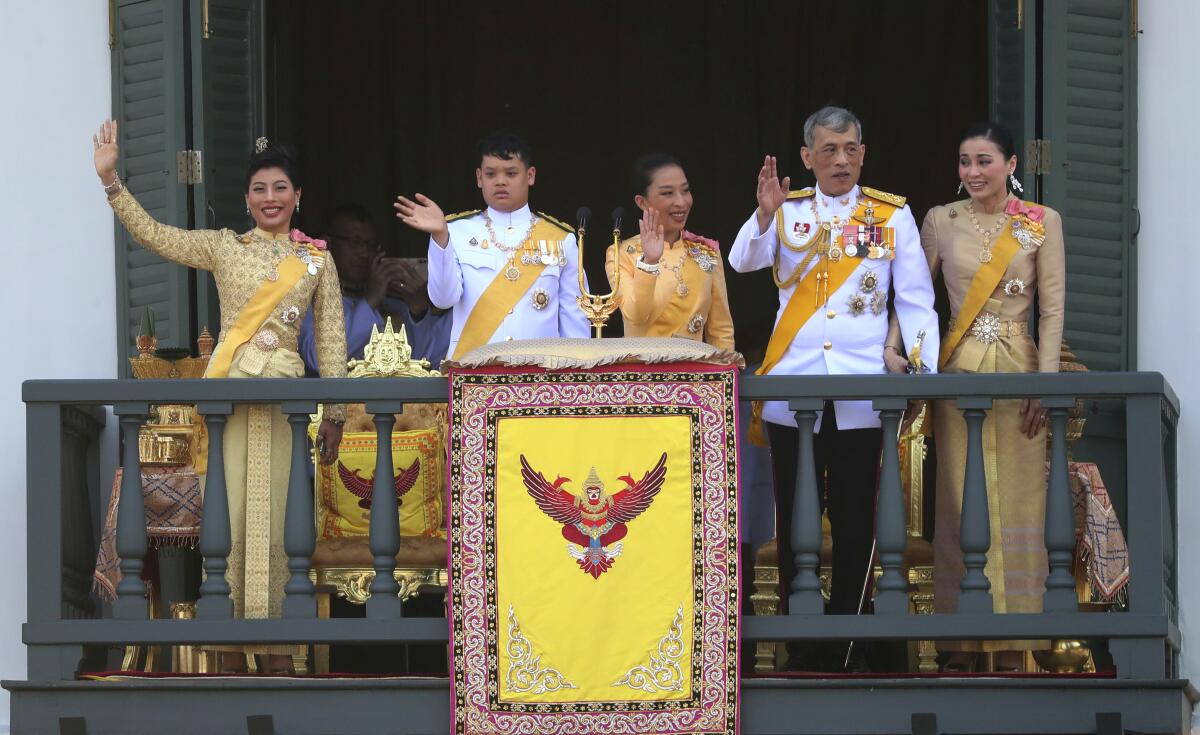
Sineenat, who was born Niramon Ounprom, graduated from the army nursing college in 2008 and worked at a military hospital, according to her official biography. She first came into public view during a ceremony in 2015, when she stood in a white military uniform onstage behind Vajiralongkorn, the recently divorced crown prince.
The following year, she was seen walking through a Munich mall with Vajiralongkorn, both clad in tight-fitting crop tops, their bodies plastered with temporary tattoos.
After Vajiralongkorn’s father, King Bhumibol Adulyadej, died in October 2016, speculation centered on whether he would marry Sineenat or his other steady companion, Suthida Tidjai, a former flight attendant who was deputy commander of his bodyguard unit.
Days before he donned a 16-pound, diamond-studded crown at his formal coronation in May 2019, Vajiralongkorn announced that he would “promote” Suthida to queen. During the ceremonies, as Suthida stood before the king inside an ornate room in the palace, cameras captured Sineenat among the onlookers, grimacing.
Two months later, on his 67th birthday, Vajiralongkorn stunned Thais by appointing Sineenat as royal noble consort — the first time that title had been used since 1921. The palace published a series of striking photos of her, including one showing her seated in an airplane cockpit wearing a camouflage-patterned sports bra.
Her disappearance and reemergence, just as the protests were gathering strength, have fueled questions about the king’s ability to operate beyond the law. Demonstrators have blamed the palace for the disappearances and deaths of several dissidents overseas, including democracy activist Wanchalearm Satsaksit, who was abducted in June in Cambodia and hasn’t been heard from since. Thai authorities have denied involvement.
Massive protests have greeted the monarch on his return to Thailand while lawmakers raise legal questions in his adopted home, Germany.
“Goy’s case is an example of what has become so normalized — this climate of fear around the king,” said Pavin, the academic, who has lived in self-exile in Japan since calling for reforms to the monarchy.
“Of course you can be rewarded, but if you upset the king one day, you could be demoted. Or not just demoted but dismissed. Or not just dismissed — maybe you could be locked up or even killed.”
::
Pavin has described the royal family as a soap opera, and its fans increasingly divide into dueling camps: Team Goy and Team Nui, the nickname of the queen. Facebook users speculate about their rivalry and pore over their outfits, jewelry and facial expressions.
Queen Suthida, 42, has been by the king’s side in public since they returned to Thailand in October, gripping his arm as they walk the receiving lines, sometimes pausing to allow supporters wearing yellow, the royal color, to kiss their feet.
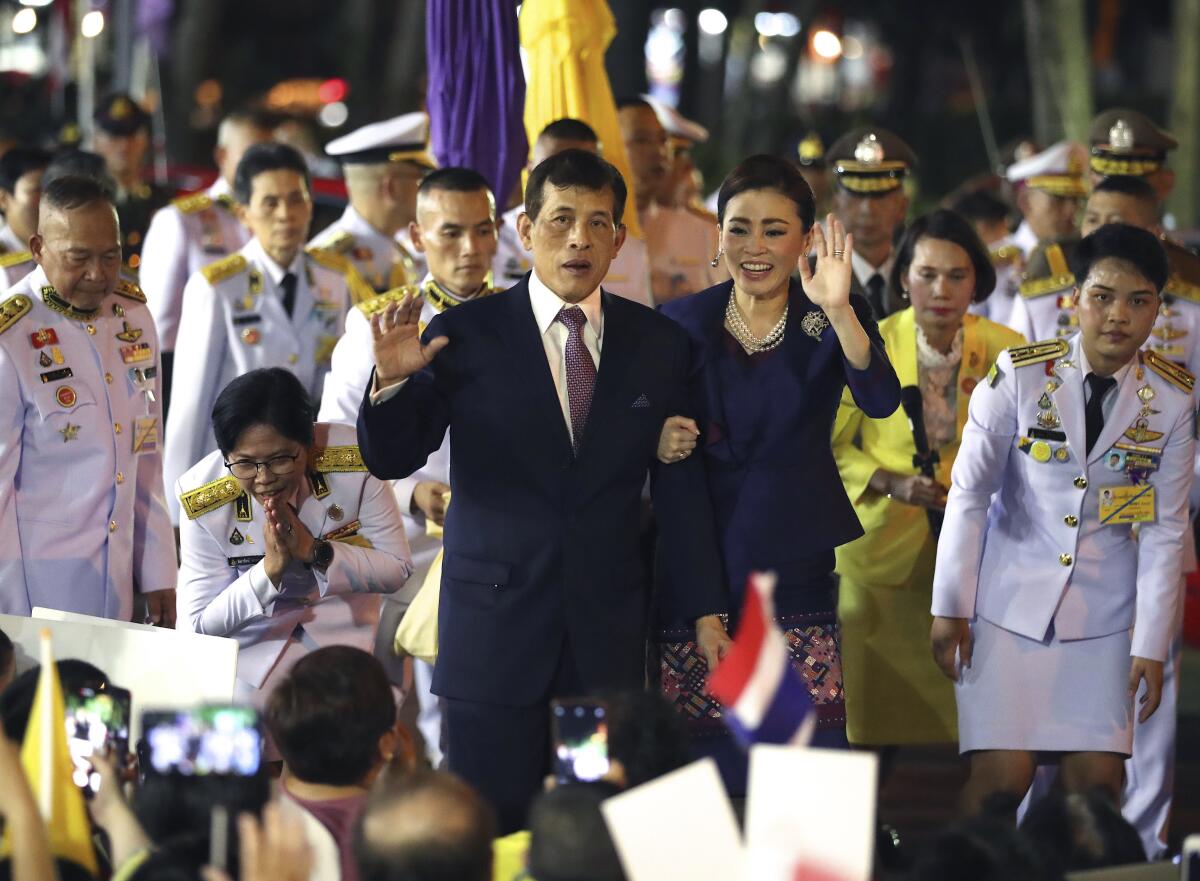
Sineenat has posed with buffalo at a nature center, met students at her old high school, tried on scarves at a clothing exhibition. This month, a clip went viral showing Sineenat outside the Grand Palace after the ceremonial changing of garments of the Emerald Buddha statue, bending down to accept paper tissues from a well-wisher, then tucking the unused tissue neatly back in the box like an earnest chambermaid.
But some Thais noticed that the ruby necklace and earrings she wore closely resembled those worn by Queen Sirikit, the king’s mother, in her younger years. During the ceremony, when Sineenat lay at the king’s feet to be anointed with holy water, Suthida looked away and appeared to sigh.
More stories from Asia
“I think they don’t all consent to this arrangement, because you still see them fighting,” a 17-year-old who gave her name only as Mimi said at a demonstration over the weekend in Bangkok, the capital. “And the king may think that he can do anything with these women because they are his assets.”
A 22-year-old fine arts student named Ai said people shouldn’t criticize Sineenat, but her appointment “has changed the way people perceive the monarchy.” Thais used to lie on the ground when a royal motorcade drove past; now some turn their backs or jeer.
But the arrests of dozens of demonstrators show that the monarchy still insists on fealty, she said, no matter how down-to-earth the royals try to appear.
“In the past, we couldn’t even look directly at their faces. Now we can take selfies with them,” Ai said. “Things change fast. But people can see through it anyway. It is an act. It is a performance.”
A special correspondent in Bangkok contributed to this report.
More to Read
Start your day right
Sign up for Essential California for news, features and recommendations from the L.A. Times and beyond in your inbox six days a week.
You may occasionally receive promotional content from the Los Angeles Times.

